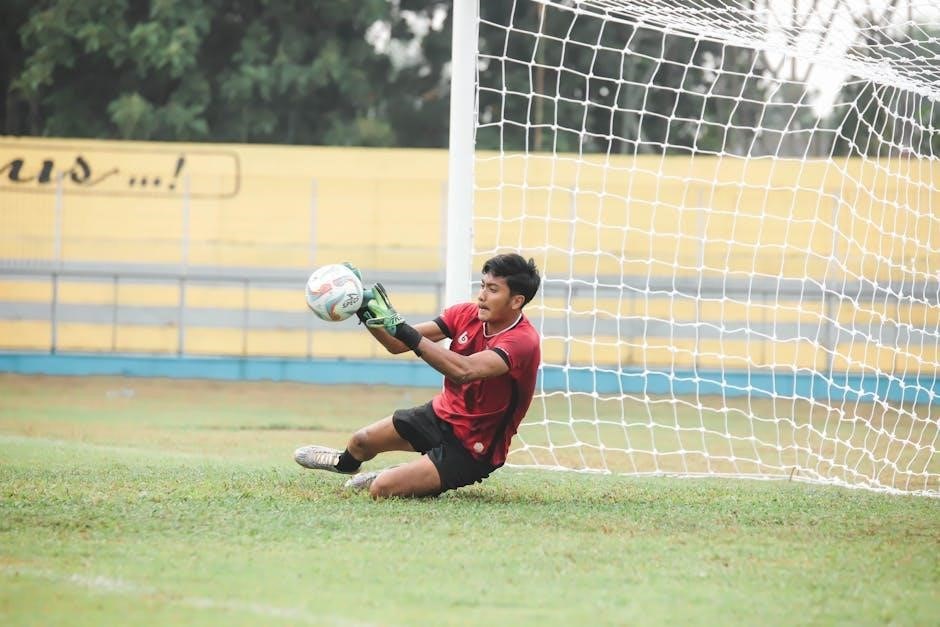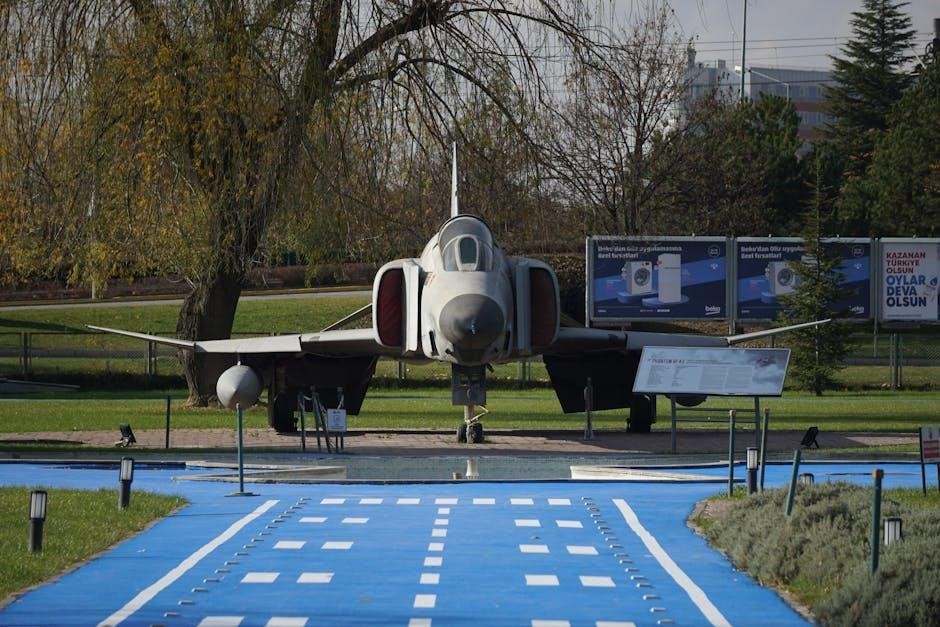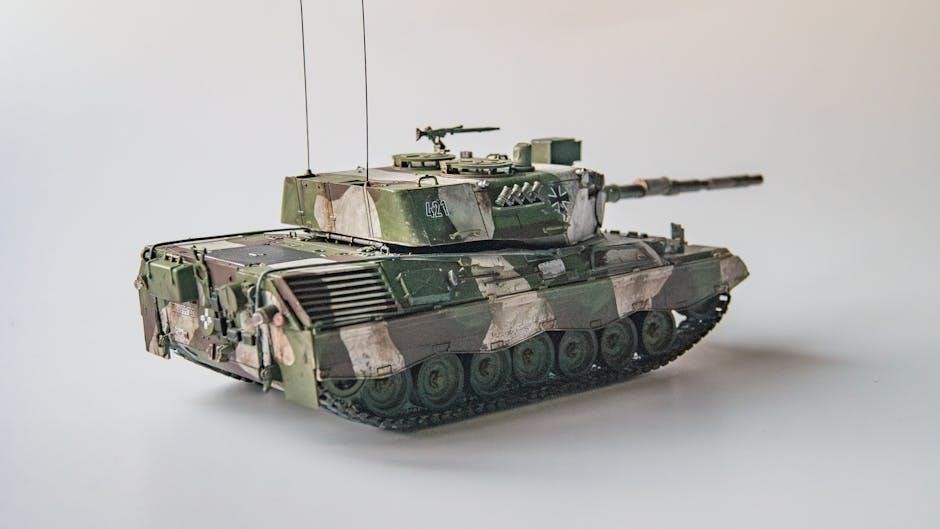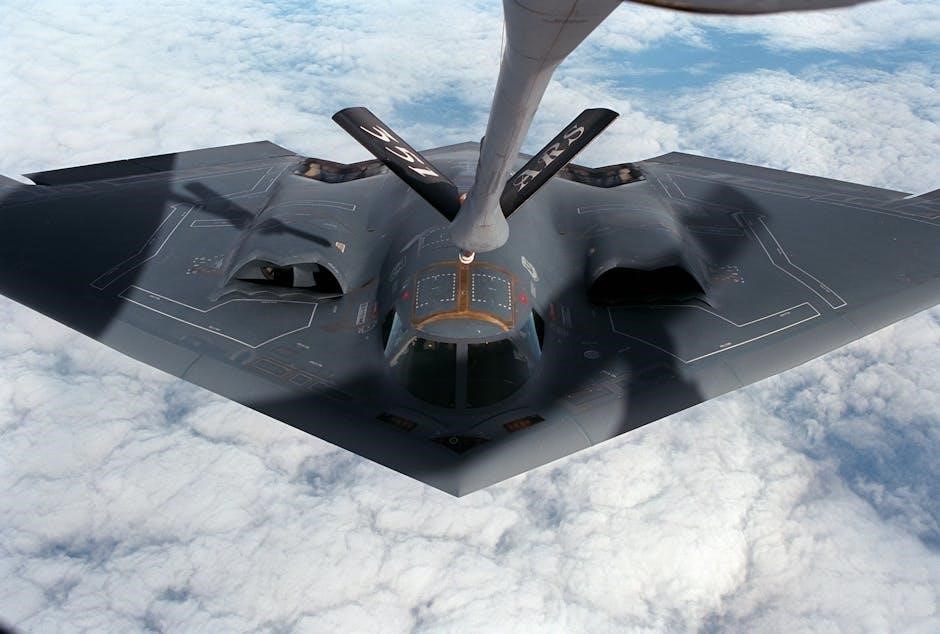The 4-2-5 defense playbook is a versatile scheme widely used in football, featuring four defensive linemen, two linebackers, and five defensive backs. It balances pass and run defense effectively, making it popular in modern football strategies.
1.1. Overview of the 4-2-5 Defense
The 4-2-5 defense is a hybrid scheme combining elements of the 4-3 and nickel defenses, featuring four defensive linemen, two inside linebackers, and five defensive backs. This setup provides flexibility against modern spread offenses while maintaining strength against the run. It is widely used in high school and college football for its adaptability and ability to disguise coverages, making it a popular choice for coaches seeking a balanced defensive approach.
1.2. Key Characteristics of the 4-2-5 Scheme
The 4-2-5 defense is a hybrid scheme blending 4-3 and nickel concepts, emphasizing flexibility and adaptability. It features four defensive linemen, two inside linebackers, and five defensive backs, with a focus on pressuring the quarterback and defending the pass. This scheme excels against spread offenses, offering versatility in coverage and blitz packages. Its ability to disguise alignments and coverages makes it challenging for offenses to predict defensive strategies, enhancing overall defensive effectiveness.
1.3. Advantages of the 4-2-5 Defense
The 4-2-5 defense offers enhanced flexibility against modern spread offenses. It allows defensive coordinators to utilize nickelbackers and hybrid players, improving pass coverage while maintaining run-stopping capabilities. The scheme’s ability to blitz from multiple angles creates pressure on the quarterback. Additionally, it provides better matchups in space, making it difficult for offenses to exploit defensive weaknesses, thus increasing overall defensive efficiency and effectiveness in various game situations.

Base Alignments in the 4-2-5 Defense
The 4-2-5 defense features four defensive linemen, two inside linebackers, and five defensive backs, including cornerbacks, a free safety, and hybrid outside linebacker/safety players.
2.1. Defensive Linemen Alignment
In the 4-2-5 defense, the four defensive linemen typically align in a 4-man front, with two defensive tackles and two defensive ends. This setup allows for gap control and pass rush effectiveness. The defensive linemen are often positioned to occupy blockers, freeing up linebackers to flow to the ball. Their alignment can vary slightly depending on the offensive formation, but the primary goal remains disrupting both the run and pass game.
2.2. Linebacker Alignment
In the 4-2-5 defense, the two linebackers usually align behind the defensive linemen, often in a stacked position. They are responsible for reading the offense and filling gaps against the run. One linebacker may play closer to the line of scrimmage, while the other operates as a rover, providing support in both run and pass defense. Their alignment can shift based on offensive personnel and formations to maximize effectiveness.
2.3; Defensive Backs Alignment
In the 4-2-5 defense, the five defensive backs include two cornerbacks, one free safety, and two hybrid players (often referred to as “Dogs”). These hybrids typically align as outside linebackers but have responsibilities that blend those of linebackers and defensive backs. The cornerbacks usually play off or press coverage, while the safeties provide deep support. The hybrid players often line up near the line of scrimmage, ready to rush or cover depending on the play call.
Coverage Schemes in the 4-2-5 Defense
The 4-2-5 defense employs a mix of man-to-man, zone, and combination coverages, offering flexibility to counter various offensive formations while maintaining defensive integrity and adaptability.
3.1. Man-to-Man Coverage
Man-to-man coverage in the 4-2-5 defense assigns each defensive back to cover a specific receiver, ensuring tight coverage and pressuring the quarterback. This scheme relies on the defensive backs’ ability to mirror routes and contest throws effectively. It is particularly effective in disrupting timing-based offenses and creating turnovers through aggressive play.
3.2. Zone Coverage
Zone coverage in the 4-2-5 defense involves defenders covering specific areas of the field rather than individual receivers. This scheme allows for better coverage against spread offenses by dividing the field into zones, with each defender responsible for a particular area. It provides underneath and deep support, enabling defenders to read the quarterback’s eyes and react to the ball. Zone coverage is flexible and simplifies adjustments, making it effective against multiple formations while limiting big plays and creating turnover opportunities.
3.3. Combination Coverage
Combination coverage blends man-to-man and zone principles, offering flexibility in the 4-2-5 defense. Defensive backs and linebackers can switch responsibilities, creating mismatches and confusing the quarterback. This hybrid approach allows defenders to cover specific receivers while others patrol zones, providing deep support and underneath coverage. Combination coverage is highly adaptable, enabling the defense to disguise its intentions, disrupt timing, and capitalize on turnovers while maintaining balanced field coverage against various offensive threats effectively.
Blitz Packages in the 4-2-5 Defense
The 4-2-5 defense incorporates aggressive blitz packages, utilizing linebackers and defensive backs to create pressure while maintaining coverage. These schemes disrupt the offense’s rhythm and timing effectively.
4.1. Linebacker Blitzes
Linebacker blitzes in the 4-2-5 defense are designed to create immediate pressure and disrupt the offense’s rhythm. They often involve inside linebackers attacking through gaps or delaying their blitz to confuse the offensive line. This versatility forces the quarterback to make quick decisions, increasing the chances of sacks or turnovers. The linebacker’s role in blitz packages is crucial for generating negative plays and controlling the game’s tempo effectively.
4.2. Defensive Back Blitzes
Defensive back blitzes in the 4-2-5 scheme add an extra layer of unpredictability. Cornerbacks and safeties often blitz from the slot or edge, exploiting offensive weaknesses. These blitzes are typically timed to catch the quarterback in a vulnerable position, leading to sacks or interceptions. The hybrid “Dogs” (OLB/S) excel in these situations, combining pass-rush skills with defensive back agility. This versatility makes defensive back blitzes a cornerstone of the 4-2-5 playbook’s aggressive philosophy.

4.3. Exotic Blitzes
Exotic blitzes in the 4-2-5 defense involve unique alignments and timing, often bringing pressure from unexpected defenders. These schemes may include cornerbacks or safeties blitzing from unconventional angles, creating confusion for the offense. The hybrid “Dogs” (OLB/S) are key in these packages, combining speed and aggression. Exotic blitzes emphasize disguise and unpredictability, forcing quarterbacks into quick decisions and increasing turnover opportunities. They highlight the 4-2-5’s flexibility and ability to adapt to modern offensive trends.

Personnel Groupings and Adjustments
The 4-2-5 defense utilizes flexible personnel groupings, often featuring hybrid players like “Dogs” (OLB/S). Adjustments are made based on offensive formations, ensuring matchup advantages and scheme versatility.
5.1. Base Personnel (4-2-5)
The base 4-2-5 personnel grouping consists of four defensive linemen, two inside linebackers, and five defensive backs. This setup includes two cornerbacks, one free safety, and two hybrid “Dog” linebackers/safeties, providing flexibility against both run and pass threats. The hybrid players are crucial for covering receivers and supporting the run defense, making this scheme adaptable to various offensive strategies and formations.

5.2. Adjustments Against Spread Offenses
Against spread offenses, the 4-2-5 defense often substitutes a defensive lineman for a nickelback, creating a 4-2-5 nickel package. This adjustment adds a fifth defensive back to counter the increased number of receivers. The hybrid “Dog” linebackers/safeties play a critical role in covering slots and tight ends while maintaining run support. This flexibility allows the defense to remain balanced against pass-heavy spread attacks without compromising its ability to stop the run.
5.3. Adjustments Against Pro-Style Offenses
Against Pro-Style offenses, the 4-2-5 defense may add an extra linebacker to strengthen the box, substituting a defensive back. This adjustment enhances run support and counters tight end-heavy formations. The defensive line focuses on occupying blockers, freeing linebackers to attack gaps. Hybrid safeties often align closer to the line to provide additional run support while maintaining coverage discipline against play-action passes.

Practice Drills for the 4-2-5 Defense
Practice drills focus on defensive line techniques, linebacker tackling, and defensive back footwork. These exercises enhance individual skills and improve teamwork, ensuring alignment and execution precision.
6.1. Defensive Back Drills
Defensive back drills focus on improving footwork, man-to-man coverage, and zone responsibilities. Backpedal and press techniques are emphasized to enhance reaction time and coverage skills. Ball drills, such as intercepting passes and reading the quarterback, simulate game situations, ensuring defensive backs can effectively defend against both short and deep routes while maintaining proper alignment and communication within the 4-2-5 scheme.
6.2. Linebacker Drills
Linebacker drills focus on enhancing tackling, play recognition, and coverage skills. Bag drills improve footwork and hand placement, while pass coverage exercises simulate man-to-man and zone responsibilities. Tackling drills emphasize proper technique to minimize missed tackles. Reaction drills test linebackers’ ability to read plays and respond quickly, ensuring they can effectively stop the run and cover receivers in the 4-2-5 scheme.
6.3. Defensive Line Drills
Defensive line drills focus on improving technique, explosiveness, and reaction time. Stance and start drills enhance explosion off the ball, while hand placement and footwork exercises refine pass rush and block-shedding skills. Bag drills simulate real-game scenarios, teaching linemen to maintain pad level and leverage. Technique drills, such as swim and rip moves, are essential for defeating blockers and creating pressure in the 4-2-5 defense.
Common Mistakes and Solutions
Common mistakes include misalignment, coverage breakdowns, and poor blitz execution. Coaches must emphasize proper technique, communication, and film study to address these issues effectively in the 4-2-5 defense.
7.1. Alignment Errors
Alignment errors in the 4-2-5 defense often stem from improper positioning of defensive linemen and linebackers. Ensuring linemen align correctly based on offensive formations and linebackers adjust their depth and spacing is crucial. Defensive backs must also maintain proper depth to provide support. Coaches should emphasize pre-snap reads and consistent communication to minimize alignment mistakes, ensuring each player understands their role within the scheme. Regular drills focused on alignment can help build muscle memory and improve overall defensive execution. Addressing these issues is essential for maintaining the integrity of the 4-2-5 defense and preventing exploit by the offense.
7.2. Coverage Breakdowns
Coverage breakdowns in the 4-2-5 defense often occur due to miscommunication or poor eye discipline. Defensive backs must maintain proper depth and leverage, while linebackers need to fill gaps correctly. Ensuring seamless coordination between zone and man coverage is critical. Coaches should emphasize pre-snap reads, assignment football, and reaction drills to improve recognition and response. Addressing these issues through film study and practice helps tighten coverage and minimize explosive plays, enhancing overall defensive performance and reliability.
7.3. Blitz Execution Issues
Blitz execution issues often stem from poor timing, lack of coordination, or overcommitting defenders. Ensuring rushers attack correct gaps and maintain proper angles is crucial. Defensive backs must provide adequate support to avoid exposed coverages. Addressing these issues requires film study, practice drills focused on timing, and a deep understanding of opponent tendencies. Enhancing communication and pre-snap alignment can significantly improve blitz effectiveness and overall defensive impact.

Game Planning Strategies
Game planning involves analyzing opponent tendencies, adjusting the 4-2-5 scheme, and preparing in-game adjustments to exploit weaknesses. It requires detailed film study and strategic execution.
8.1. Opponent Tendencies
Understanding opponent tendencies is crucial in the 4-2-5 defense playbook. Teams often study film to identify patterns in the opponent’s play-calling, such as run-pass tendencies or formation preferences. This knowledge helps defensive coordinators anticipate and counter common offensive strategies. For example, offenses frequently use 3-WR sets to exploit matchups, prompting the 4-2-5 to adjust its base personnel or coverage schemes; Analyzing these tendencies allows for more effective game planning and in-game adjustments.
8.2. Adjusting the 4-2-5 Scheme
Adjusting the 4-2-5 scheme involves tailoring the defense to counter specific offensive strengths. Coaches may shift personnel groupings or alter alignments based on the opponent’s playbook. For example, against spread offenses, the defense might employ nickel packages or hybrid players to match up with receivers. Flexibility in coverage and blitz packages allows the 4-2-5 to remain effective against diverse offensive systems while maintaining its core defensive philosophy.
8.3. In-Game Adjustments
In-game adjustments for the 4-2-5 defense involve real-time tweaks to counter the opponent’s strategy. Coaches analyze offensive tendencies and modify coverages, blitz packages, or alignments as needed. These adjustments ensure the defense remains one step ahead, exploiting weaknesses while maintaining the scheme’s flexibility. Effective communication and quick execution by players are critical to implementing these changes seamlessly during the game.

Resources and Playbooks
Explore the 4-2-5 defense playbook through recommended resources like Joe Daniel’s playbook, Brent Venables’ strategies, and online platforms offering detailed schemes, drills, and adjustments for coaches.
9.1. Recommended Playbooks
For coaches implementing the 4-2-5 defense, recommended playbooks include Joe Daniel’s “FourthDown PlayBook” and Brent Venables’ defensive strategies. The 34 Defense Playbook and FirstDown PlayBook also offer valuable insights, providing detailed schemes, drills, and adjustments. These resources are essential for understanding base alignments, coverage schemes, and blitz packages, helping coaches optimize their team’s performance effectively.
9.2. Online Resources
Online resources for the 4-2-5 defense playbook include Joe Daniel’s “FourthDown PlayBook,” offering free foundations videos and premium coaching content. FirstDown PlayBook provides youth football plays designed by NFL coaches. Additionally, virtual football summits like Blitz Essentials share insights from top coaches, covering base schemes, drills, and in-game adjustments. These platforms are invaluable for coaches seeking to master the 4-2-5 defense and adapt it to their teams’ needs effectively.
9.3. Coaching Clinics
Coaching clinics offer hands-on training for mastering the 4-2-5 defense. Clinics led by experienced coaches like Joe Daniel and Cameron Soran provide detailed insights into scheme installation, player drills, and game planning. These events often feature live demonstrations and Q&A sessions, helping coaches adapt the 4-2-5 defense to their team’s strengths. Attendees gain practical knowledge to enhance their defensive strategies and improve player execution effectively.
